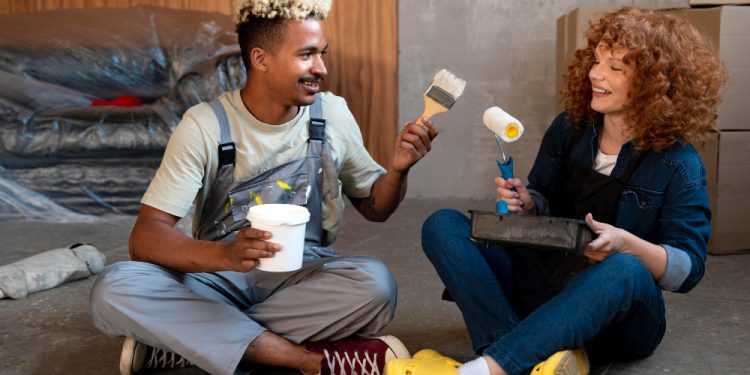A fresh coat of paint is one of the simplest and most affordable ways to completely transform a home’s interior. Yet, anyone who has ever picked up a roller knows that getting a professional-level finish isn’t as easy as it looks. Paint streaks, uneven coverage, and drips can quickly turn a DIY project into a frustrating experience.
Professional painters spend years refining their techniques to achieve flawless, long-lasting results — but there are a few secrets they rarely share. Here are the insider tips and strategies that can help you paint like a pro and get stunning results that rival the work of a leading Colorado Springs painting company.
1. Prep Work is 80% of the Job
Professionals know that the secret to a beautiful finish starts long before the first brush stroke. Prep work determines how well your paint will adhere and how smooth your walls will look once it’s dry.
Start by cleaning your walls with a mild detergent to remove grease, dust, and grime. Repair nail holes, cracks, or imperfections using spackle and a putty knife. Sand everything lightly to create a smooth surface, then wipe it clean with a damp cloth.
Once that’s done, tape off trim, windows, and fixtures with painter’s tape. Cover floors and furniture with drop cloths. Skipping these steps is one of the biggest mistakes DIY painters make — and it’s why pros spend more time prepping than painting.
2. Use Primer Every Time
Many homeowners assume primer is optional, but professionals know better. Primer seals porous surfaces, covers stains, and provides a uniform base for color. It ensures that your final coats adhere properly and look even across the entire wall.
If you’re painting over dark colors, new drywall, or patched areas, primer is essential. Some high-quality paints include built-in primers, but most pros still prefer a dedicated primer layer for the best adhesion and color depth.
A seasoned Colorado Springs painting company would never paint directly over bare drywall or old paint without priming first — and neither should you.
3. Don’t Skimp on Paint Quality
Cheap paint can end up costing you more in the long run. Lower-quality paint tends to streak, require more coats, and fade faster. Professionals always choose premium-grade paints because they provide better coverage, richer color, and longer durability.
For interiors, low- or zero-VOC (volatile organic compounds) paints are ideal since they reduce odor and improve indoor air quality. Choose finishes based on the room’s function: matte or eggshell for living areas, satin or semi-gloss for kitchens and bathrooms, and high-gloss for trim or cabinetry.
4. Master the Brush and Roller Technique
Even the best paint won’t look great without proper application. The key is maintaining a “wet edge” — meaning you overlap each new stroke slightly with the previous one before it dries. This prevents visible lap marks.
Use long, steady strokes and roll in a “W” or “M” pattern to distribute paint evenly. Avoid pressing too hard on the roller; let the paint do the work. For edges and corners, a high-quality angled brush gives the most precision.
Professional painters also know when to stop. Over-brushing or re-rolling after the paint starts to dry can cause streaks and uneven texture.
5. Watch the Weather — Even Indoors
Believe it or not, temperature and humidity affect interior painting just as much as exterior projects. If it’s too cold or too humid, paint can take longer to dry or fail to cure properly. Ideally, paint indoors when temperatures range between 60°F and 80°F, with moderate humidity.
Dry climates like Colorado’s can cause paint to dry too fast, leading to visible roller marks or brush lines. That’s why many professionals — including those who follow the same best practices as a Colorado Springs painting company — use paint extenders or conditioners to slow the drying process for a smoother finish.
6. Two Coats Are Always Better Than One
Even if the first coat looks good, pros always apply two coats. The first layer provides coverage, while the second deepens color, enhances durability, and hides any missed spots. Skipping the second coat often results in a flat, uneven finish that fades faster.
Allow the first coat to dry fully before applying the second. Rushing the process traps moisture and can cause peeling or bubbling down the road.
7. The Finishing Touches Matter
Once the paint is dry, carefully remove painter’s tape while the paint is still slightly tacky — this helps create crisp, clean edges. Replace outlet covers, light switch plates, and wall décor once the paint has fully cured.
Finally, store any leftover paint properly in a cool, dry place. Label each can with the color name, finish, and room where it was used. This makes future touch-ups easy and precise.
Final Thoughts
Painting is one of those tasks that seems simple but rewards precision and patience. By following the same steps professional painters use — meticulous prep, priming, premium paint, and careful application — you can achieve results that look like they came straight from a high-end Colorado Springs painting company.
When done right, a fresh coat of paint doesn’t just refresh your walls; it revitalizes your entire home. The payoff is a clean, vibrant space that reflects your personality, adds value, and brings new life to your surroundings.














